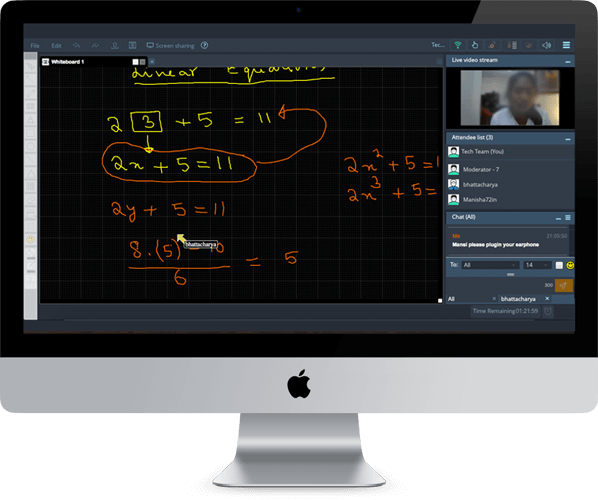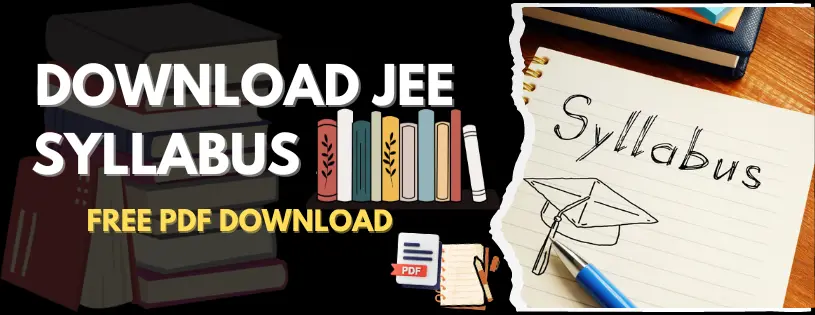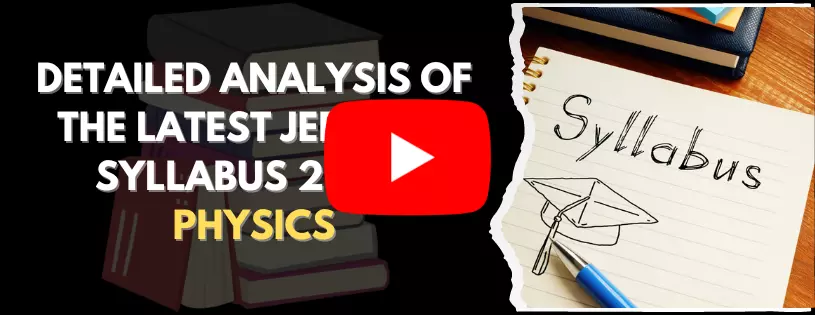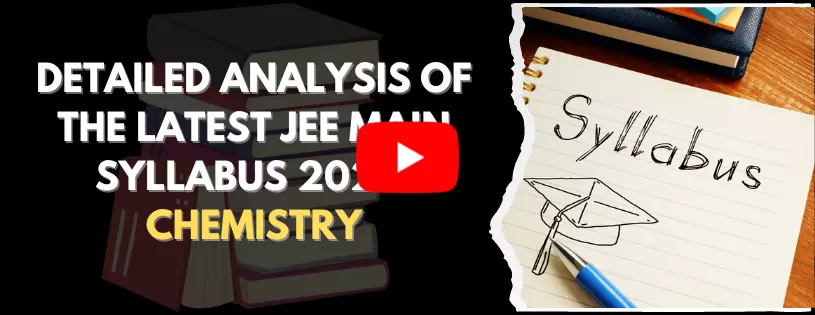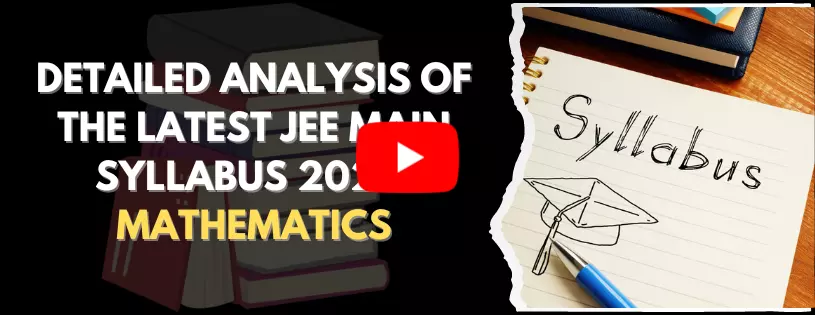Download JEE Main Syllabus 2025 Free PDF Download
JEE is one of the most competitive exam, and getting to know the syllabus for each section of Physics, Chemistry, and Mathematics is very crucial. The Syllabus of JEE gives you an idea of the important topics and the distribution of marks and insight into how to plan your preparation. JEE Main 2025-26 aspirants can download the Latest JEE Main Syllabus to be aware of the chapters to learn.
Download JEE Syllabus 2025 - Free PDF Download
The JEE Main Syllabus is divided into two parts class 11th and class 12th, in simple words, JEE Main Syllabus contains 60% weightage from class 12th and the remaining 40% weightage from grade 11th. These figures can also help you figure out & improve the areas of your strengths and weaknesses.
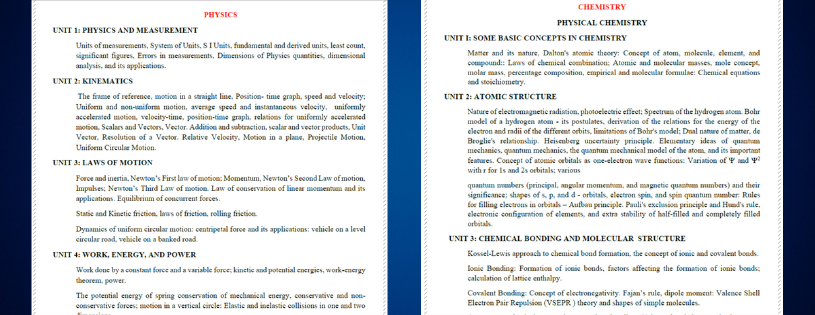
Get IIT JEE Prep Help Download DASA/CIWG E-BOOK
JEE Main Physics Syllabus
Students can check the JEE Main Physics Syllabus given below and download the Free PDF of Syllabus. You can also download the free Best Physics Book for IIT JEE.
| Unit Number | JEE Main 2025 Physics Syllabus |
| 1 | PHYSICS AND MEASUREMENT |
| 2 | KINEMATICS |
| 3 | LAWS OF MOTION |
| 4 | WORK, ENERGY, AND POWER |
| 5 | ROTATIONAL MOTION |
| 6 | GRAVITATION |
| 7 | PROPERTIES OF SOLIDS AND LIQUIDS |
| 8 | THERMODYNAMICS |
| 9 | KINETIC THEORY OF GASES |
| 10 | OSCILLATIONS AND WAVES |
| 11 | ELECTROSTATICS |
| 12 | CURRENT ELECTRICITY |
| 13 | MAGNETIC EFFECTS OF CURRENT AND MAGNETISM |
| 14 | ELECTROMAGNETIC INDUCTION AND ALTERNATING CURRENTS |
| 15 | ELECTROMAGNETIC WAVES |
| 16 | OPTICS |
| 17 | DUAL NATURE OF MATTER AND RADIATION |
| 18 | ATOMS AND NUCLEI |
| 19 | ELECTRONIC DEVICES |
| 20 | EXPERIMENTAL SKILLS |
JEE Main Chemistry Syllabus
JEE Main Chemistry Syllabus consists of 3 subjects Physical Chemistry, Organic and Inorganic Chemistry. The given below table is the list of the Chemistry syllabus. You can also download the free Best Books for Chemistry IIT JEE . Students can download the JEE Main Chemistry Syllabus PDF from given below link.
| Unit Number | JEE Main 2025 Chemistry Syllabus |
| 1 | SOME BASIC CONCEPTS IN CHEMISTRY |
| 2 | ATOMIC STRUCTURE |
| 3 | CHEMICAL BONDING AND MOLECULAR STRUCTURE |
| 4 | CHEMICAL THERMODYNAMICS |
| 5 | SOLUTIONS |
| 6 | EQUILIBRIUM |
| 7 | REDOX REACTIONS AND ELECTROCHEMISTRY |
| 8 | CHEMICAL KINETICS |
| 9 | CLASSIFICATION OF ELEMENTS AND PERIODICITY IN PROPERTIES |
| 10 | P- BLOCK ELEMENTS |
| 11 | d - and f- BLOCK ELEMENTS |
| 12 | CO-ORDINATION COMPOUNDS |
| 13 | PURIFICATION AND CHARACTERISATION OF ORGANIC COMPOUNDS |
| 14 | SOME BASIC PRINCIPLES OF ORGANIC CHEMISTRY |
| 15 | HYDROCARBONS |
| 16 | ORGANIC COMPOUNDS CONTAINING HALOGENS |
| 17 | ORGANIC COMPOUNDS CONTAINING OXYGEN |
| 18 | ORGANIC COMPOUNDS CONTAINING NITROGEN |
| 19 | BIOMOLECULES |
| 20 | PRINCIPLES RELATED TO PRACTICAL CHEMISTRY |
JEE Main Mathematics Syllabus PDF
JEE Main Mathematics Syllabus is given below in the table along with the name of chapter and number of topics on the chapters.
| Unit Number | JEE Main 2025 Mathematics Syllabus |
| 1 | SETS, RELATIONS, AND FUNCTIONS |
| 2 | COMPLEX NUMBERS AND QUADRATIC EQUATIONS |
| 3 | MATRICES AND DETERMINANTS |
| 4 | PERMUTATIONS AND COMBINATIONS |
| 5 | BINOMIAL THEOREM AND ITS SIMPLE APPLICATIONS |
| 6 | SEQUENCE AND SERIES |
| 7 | LIMIT, CONTINUITY, AND DIFFERENTIABILITY |
| 8 | INTEGRAL CALCULAS |
| 9 | DIFFRENTIAL EQUATIONS |
| 10 | CO-ORDINATE GEOMETRY |
| 11 | THREE DIMENSIONAL GEOMETRY |
| 12 | VECTOR ALGEBRA |
| 13 | STATISTICS AND PROBABILITY |
| 14 | TRIGONOMETRY |

Download NRI JEE Prep eBook

FAQs on JEE Main Syllabus
Q.1. What is the syllabus for JEE Main?
Ans- The JEE Main syllabus includes topics from Physics, Chemistry, and Mathematics that are typically covered in the 11th and 12th-grade CBSE/State Board curriculam.
Q.2. Is the JEE Main syllabus the same every year?
Ans- The core topics remain consistent, but there might be slight variations or additions to the syllabus from year to year. It's recommended to refer to the official JEE Main website (nta.ac.in) or brochure for the most current syllabus.
Q.3. How can I get the detailed syllabus for JEE Main?
Ans- You can find the detailed syllabus for JEE Main on the website of TestprepKart or on the official website of the National Testing Agency (NTA).
Q.4. Are there any specific reference books for JEE Main syllabus?
Ans-While there are numerous reference books available for JEE Main preparation, it's essential to align your study material with the official syllabus. Many renowned publishers offer books that cover the JEE Main syllabus comprehensively.
Q.5. Are all topics of the 11th and 12th-grade CBSE syllabus covered in JEE Main?
Ans-The majority of topics from the CBSE syllabus are covered in JEE Main, but the depth of coverage might vary. Some topics might be emphasized more due to their relevance in the exam.
Q.6. Are there any additional topics beyond the CBSE syllabus?
Ans- Generally, JEE Main sticks to the CBSE/State Board syllabus, but some topics might be introduced at a slightly higher level of difficulty. It's always recommended to focus on the prescribed syllabus before exploring beyond.
Q.7. How can I effectively cover the entire syllabus?
Ans- Break down the syllabus into smaller portions and create a study schedule. Allocate time for each subject and topic, and ensure you cover theory, problem-solving, and revision. Regular practice and mock tests are crucial.
Q.8. Are practicals from the CBSE syllabus also included in JEE Main?
Ans-JEE Main primarily focuses on theoretical concepts and problem-solving. While understanding practical applications can be beneficial, the exam doesn't directly test practical skills as in CBSE board exams.
Q-9. Is it possible to score well by only focusing on selective topics?
Ans- While focusing on important topics is a good strategy, JEE Main tests a broad range of concepts. It's advisable to have a well-rounded understanding of the entire syllabus to perform consistently well.
Q.10. Can I find previous years' questions based on the syllabus?
Ans-Yes, previous years' question papers are a valuable resource for understanding the exam pattern and the types of questions asked. They can help you gauge the depth of coverage for each topic.
